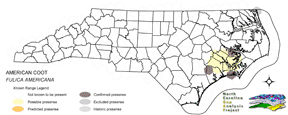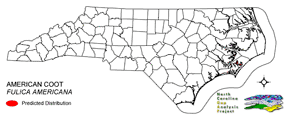
| Taxa: |
| Order: |
| Family: |
| Aves |
| Gruiformes |
| Rallidae |
| NatureServe Global Rank: |
| NatureServe State (NC) Rank: |
| G5 |
| SAB,S5N |
| Federal Status: |
| NC State Status: |
| --- |
| --- |


| Land Unit |
| US Fish & Wildlife Service |
| US Forest Service |
| US National Park Service |
| US Department of Defense |
| NC State Parks |
| NC University System |
| NC Wildlife Res. Com. |
| NC Forest Service |
| NC Div. of Coastal Mgmt. |
| Local Governments |
| Non-Governmental Org. |
| Other Public Lands |
| Private Lands |
| GAP Status 1-2 |
| All Protected Lands |
| Statewide |
| Hectares |
| 2,579.67 |
| 285.39 |
| 4,493.61 |
| 179.37 |
| 137.79 |
| 140.31 |
| 545.85 |
| 0.00 |
| 119.16 |
| 5.76 |
| 857.52 |
| 0.00 |
| 20,341.98 |
| 4,026.87 |
| 9,338.67 |
| 29,686.41 |
| Acres |
| 6,374.50 |
| 705.21 |
| 11,103.95 |
| 443.23 |
| 340.49 |
| 346.71 |
| 1,348.82 |
| 0.00 |
| 294.45 |
| 14.23 |
| 2,118.98 |
| 0.00 |
| 50,266.12 |
| 9,950.61 |
| 23,076.35 |
| 73,356.70 |
| % of Dist. on |
| Prot. Lands |
| 27.6 % |
| 3.1 % |
| 48.1 % |
| 1.9 % |
| 1.5 % |
| 1.5 % |
| 5.8 % |
| 0.0 % |
| 1.3 % |
| 9.2 % |
| 9.2 % |
| 0.0 % |
| 0.0 % |
| 43.1 % |
| ----- |
| ----- |
| % of Dist. on |
| All Lands |
| 8.7 % |
| 1.0 % |
| 15.1 % |
| 0.6 % |
| 0.5 % |
| 0.5 % |
| 1.8 % |
| 0.0 % |
| 0.4 % |
| < 0.1 % |
| 2.9 % |
| 0.0 % |
| 68.5 % |
| 13.6 % |
| ----- |
| ----- |
|
Known to breed in Pamlico County; local permanent resident and occasional on other parts of the coast and barrier islands, but breeding status uncertain (Fussell 1994, Fussell and Lyons 1990, Potter et al. 1980). Found in water lined with emergent vegetation; prefers fresh water (Taylor 1998) but will also nest in brackish water. Habitats include ponds, lakes, impoundments, brackish estuaries (Fussell 1994), wet meadows, and marshes (Harrison 1975). Will use seasonal wetlands if water levels are sufficiently high for nesting. Requires the presence of less vegetation than does the Common Moorhen (Taylor 1998). Nest is built as an island of floating dead vegetation in water about 1 to 4 feet deep (Harrison 1975), and located 3 to 50 feet from open water in dense vegetation or sometimes in the open, resting on matted vegetation (Taylor 1998). NATURE SERVE GLOBAL HABITAT COMMENTS: Freshwater lakes, ponds, marshes, and larger rivers, wintering also on brackish estuaries and bays. Also on land bordering these habitats. Calm open water with plenty of algae and other aquatic vegetation (Stiles and Skutch 1989). Typically builds floating nest among marsh plants in 30-100 cm of water (Harrison 1979). In south-central Saskatchewn, nesting habitat and reproductive effort and success were greatly reduced during drought (Sutherland 1991). |
| Code | Name | Description | NC Natural Heritage Program Equivalent |
| 3 | Tidal Marsh | Fresh and brackish tidal marshes, including cord grass, wild rice, sawgrass and needlerush alliances. | Brackish Marsh, Interdune pond, Maritime wet grassland |
| 124 | Maritime Scrubs and Tidal Shrublands | Coastal shrubs including wax-myrtle, swamp rose, alder, yaupon, and greenbriar. | Maritime Shrubs, Salt Shrub |
| 372 | Interdune Herbaceous Wetlands | Dune swales with permanently flooded to intermittently exposed hydrology. Species composition depends on salinity and can include cut grass, spike-rush, mosquito fern, and hornwort. | Interdune Pond, Maritime Wet Grasslands |
| 380 | Coastal Plain Fresh Water Emergent | Emergent vegetation in fresh water seepage bogs, ponds and riverbeds of the coastal plain. Includes alliances dominated by sedges, eelgrass, as well as cane found in unforested cane-brakes. | Small Depression Pond, Sandhill Seep, Floodplain Pool, Unforested Floodplain Canebrake, Riverscour Prairies, Vernal Pools |
| 173 | Coastal Plain Riverbank Shrubs | Shrub dominated riverbanks, commonly dominated by willows and/or alders. | Sand and Mud Bar |
| 238 | Piedmont/Mountain Submerged Aquatic Vegetation | Seasonally to permanently flooded areas with aquatic vegetation. Waterlily, pondweed, hydrilla smartweed are a few of the species that can occur. | Piedmont/Mountain Semipermanent Impoundment (in part) |
| 239 | Piedmont/Mountain Emergent Vegetation | Emergent vegetation of all wetland hydrologies. Sites would commonly support species such as tussock sedge, rushs, and cattail alliances. | Rocky Bar and Shore (in part) |
| 267 | Riverbank Shrublands | Riverside shrubs with temporarily flooded hydrologies. Found in the both the Mountains and Piedmont. Containing dominants such as smooth alder and a Carolina or black willows. | Sand and Mud Bar |
| 8 | Open water | Open water without aquatic vegetation. | No equivalent |
|
Eddleman, W. R., F. L. Knopf, B. Meanley, F. A. Reid, and R. Zembal. 1988. Conservation of North American rallids. Wilson Bulletin 100:458-475.
Bent, A. C. 1926. Life histories of North American marsh birds. U.S. National Museum Bulletin No. 135. [reprint. 1963. Dover Publications, Inc., New York, New York]. Fussell, J. III and M. Lyons. 1990. Birds of the Outer Banks [pamphlet]. Eastern National Parks and Monument Association Coastal Wildlife Refuge Society. Lang, A. 1991. Status report on the American coot. Committee on the Status of Endangered Wildlife in Canada. 24 pp. Banks, R. C. 1995. Taxonomic Validation for Bird Species on the U.S. Fish and Wildlife Service Category 2 Species List. In Biological Survey Project, Patuxent Environmental Research Center, National Biological Service (compilers). Taxonomic Review of Cate Fussell, J.O. III. 1994. A birderís guide to coastal North Carolina. Chapel Hill and London: The University of North Carolina Press. Harrison, H.H. 1975. A field guide to bird's nests in the U.S. east of the Mississippi River. Houghton Mifflin Company, Boston, Massachusetts. 257 p. Harrison, H.H. 1979. A field guide to western birds' nests. Houghton Mifflin Company, Boston. 279 pp. Byrd, G. V., et al. 1985. Notes on the breeding biology ofthe Hawaiian race of the American coot. 'Elepaio 45:57-63. Potter, E. F., J. F. Parnell, and R. P. Teulings. 1980. Birds of the Carolinas. Univ. North Carolina Press, Chapel Hill. 408 pp. Terres, J.K. 1980. The Audubon Society encyclopedia of North American birds. Alfred A. Knopf, New York. Berger, A.J. 1981. Hawaiian Birdlife. Second Edition. University of Hawaii Press, Honolulu, Hawaii. xv + 260 pp. Scott, J. M., and C. B. Kepler. 1985. Distribution and abundance of Hawaiian native birds:a status report. Pages 43-70 in Temple, S. A. (editor). Bird Conservation 2. University of Wisconsin Press, Madison, Wisconsin. 181 pp. American Ornithologists' Union (AOU), Committee on Classification and Nomenclature. 1983. Check-list of North American Birds. Sixth Edition. American Ornithologists' Union, Allen Press, Inc., Lawrence, Kansas. Raffaele, H.A. 1983. A guide to the birds of Puerto Rico and the Virgin Islands. Fondo Educativo Interamericano, San Juan, Puerto Rico. 255 pp. Pratt, H. D. 1987. Occurrence of the North American coot (FULICA AMERICANA AMERICANA) in the Hawaiian Islands, with comments on the taxonomy of the Hawaiian coot. `Elepaio 47(3):25-28. Stiles, F.G., and A.F. Skutch. 1989. A guide to the birds of Costa Rica. Comstock Publ. Associates, Cornell University Press, Ithaca, New York. 511 pp. Lang, A. L. 1991. Status of the American coot, FULICA AMERICANA, in Canada. Can. Field-Nat. 105:530-541. Sutherland, J. M. 1991. Effects of drought on American coot, FULICA AMERICANA, reproduction in Saskatchewan parklands. Canadian Field-Naturalist 105:267-273. |
For more information please contact them at:
NC-GAP Analysis Project
Dept. of Zoology, NCSU
Campus Box 7617
Raleigh, NC 27695-7617
(919) 513-2853
www.basic.ncsu.edu/ncgap